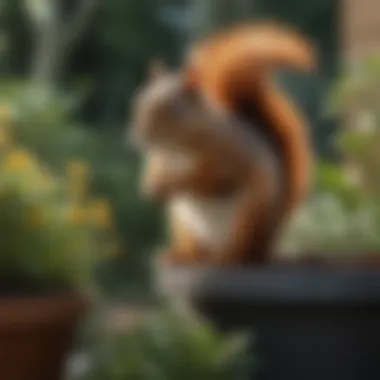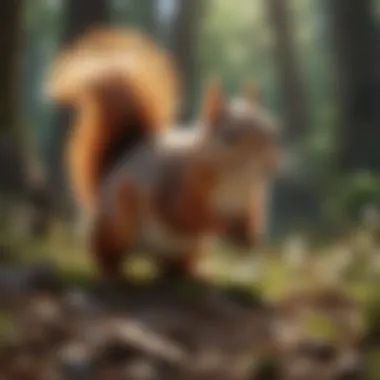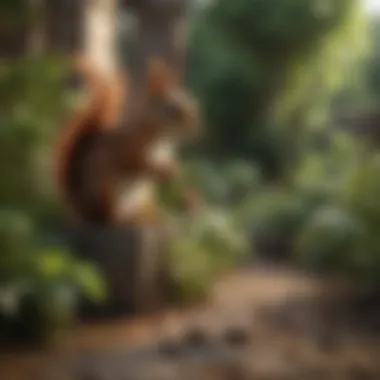Effective Strategies to Deter Squirrels from Pots


Intro
Squirrels can be charming creatures, prancing about and foraging in gardens. However, their enthusiastic digging can lead to substantial damage in pots, particularly for those who nurture delicate plants. Understanding how to deter these agile pests is crucial for maintaining a healthy garden. This article delves into effective measures that homeowners and gardeners can adopt to safeguard their pots from unwelcome squirrel visitors.
Key Insights and Trends
Understanding Squirrel Behavior
Squirrels are known for their resourcefulness and tenacity. They often dig in pots searching for seeds, bulbs, or even tender roots. Recognizing their habits allows for more targeted prevention strategies. Learning about what attracts squirrels helps identify the best defensive methods.
Popular Gardening Techniques of the Season
As gardening techniques evolve, so do methods to fend off common pests. For instance, using raised garden beds can minimize squirrel access. Moreover, companion planting, or growing certain plants together, can create a hostile environment for squirrels due to the strong scents of specific herbs. Mints and garlic are examples of plants known to deter these animals.
Practical Tips and How-To Guides
Step-by-Step Guide to Squirrel-Proofing Pots
- Physical Barriers: Using mesh or wire fencing around pots can act as a barrier. Ensure that the fencing has openings no larger than 1 inch.
- Natural Deterrents: Sprinkling cayenne pepper or using commercial squirrel repellents can discourage squirrels from digging in pots. Apply these substitutes regularly, especially after watering.
- Visual Deterrents: Items such as reflective tape or old CDs hung around the garden create movement and light, which can frighten squirrels away.
- Strategic Planting: Planting in layers can also help. For instance, taller plants can shield smaller ones, reducing the temptation for squirrels to explore below.
- Offer Alternatives: Sometimes, providing alternative food sources through bird feeders can distract squirrels. This can lessen their inclination to invade your pots.
Culmination and Synthesis
In summary, dealing with squirrels requires a combination of understanding their behavior and employing varied preventative measures. By integrating effective physical barriers, natural substances, and alternative food sources, gardeners can create an environment that minimizes squirrel interference. This not only promotes healthier plants but enhances overall gardening satisfaction.
"A proactive approach in squirrel management results in healthier gardens and happier gardeners."
By implementing the strategies outlined in this article, homeowners and gardening enthusiasts can equip themselves with valuable knowledge that fosters a flourishing garden free from squirrel disruption.
Understanding Squirrel Behavior
Understanding squirrel behavior is essential for anyone looking to protect their garden pots effectively. Squirrels are often seen as mere garden nuisances, but their behaviors are complex and rooted in ecological roles that can significantly impact gardens. By comprehending how squirrels operate, one can devise effective strategies to deter them. Their habits, preferences, and needs inform the best ways to protect plants in pots.
Ecological Role of Squirrels
Insectivores and Herbivores
Squirrels are primarily herbivores, meaning they consume a variety of plants, nuts, and seeds. However, they exhibit insectivorous behaviors as well, eating insects when available. This dual diet is crucial in understanding why certain plants attract them. Their tendency to seek out specific food sources makes them likely to invade urban gardens, especially those with thriving vegetation. By learning which plants are appealing to squirrels, gardeners can make informed choices about what to grow.
Key characteristics of this behavior include:
- Diet Variety: Squirrels adapt their diet based on availability.
- Ecological Impact: They play a role in controlling insect populations.
Thus, recognizing their feeding habits is a popular choice among those seeking to protect their garden pots.
Seed Dispersal Impact
Squirrels are also known for their significant role in seed dispersal. They collect seeds and nuts, often burying them for later consumption. Some of these seeds are forgotten and therefore contribute to plant growth elsewhere. This natural process can enrich ecosystems but also leads to an increase in squirrel activity in places with plentiful food sources.
The unique feature of this behavior lies in its dual effect:
- Plant Growth: Squirrels assist in propagation of various plant species.
- Resource Competition: However, they may also compete with gardeners for valuable seeds.
This aspect of squirrel behavior is beneficial for ecosystems but presents a challenge for garden pots.
Interaction with Other Wildlife
Squirrels do not exist in isolation; their behaviors influence and are influenced by other wildlife. They often interact with other animals, including birds and small mammals, which also might be attracted to garden pots. Understanding these interactions can help homeowners see the bigger picture of pest management.
Characteristics to note include:
- Symbiotic Relationships: Squirrels may assist other species in locating food.
- Increased Competition: Their presence can draw additional wildlife, further complicating garden preservation.
The interaction with other wildlife makes this insight a valuable choice when considering how best to keep squirrels out of pots.
Attraction to Garden Pots
Nesting Habits and Material Gatherers
Squirrels are notorious for their nesting habits. They tend to use materials from their surroundings, including twigs and plant debris, to build nests. When these materials are readily available, especially in gardens, squirrels may feel more inclined to invade.


Key points about their nesting include:
- Urgency for Resources: Squirrels often seek materials for nesting during certain seasons.
- Proximity to Food Sources: Nesting sites close to food mean higher chances of repeated visits.
Understanding these habits is vital for Gardner’s aiming to reduce squirrel presence in pots.
Food Sources in Urban Gardens
Urban gardens can treat squirrels like a buffet. They provide abundant food options, which attract them to pots. This includes leftover seeds, vegetables, and fruits, which make gardens particularly appealing.
Important insights include:
- Diverse Options: The more variety there is, the more attractive the garden becomes.
- Less Competition: In urban areas, food might be less competitive compared to wooded areas.
For this article, recognizing these food sources is key to understanding their motivation for invading garden pots.
Scent and Sight Cues
Squirrels are guided by their senses. They rely heavily on scent to locate food and nesting materials, and sight to identify opportunities. They can quickly detect the scents of other animals or food sources, making gardens with strong odors attractive.
Consider these aspects:
- Scent Marking: Squirrels can leave scent markers in areas they frequent.
- Visual Targets: Bright colors or movement can alert them to food sources.
Thus, recognizing these cues is a beneficial element in preventing squirrels from accessing pots.
Consequences of Squirrel Infestation
Understanding the consequences of squirrel infestation is crucial for effective gardening. These consequences can significantly impact both the health of plants and the overall gardening experience. Gardeners must be aware of how squirrels can interfere with their plants, leading to undesirable outcomes. Recognizing these impacts helps in implementing better preventive strategies, ensuring healthier and more productive gardens.
Impact on Plant Health
Squirrels are often seen as charming creatures, but they can pose numerous threats to garden plants. Their actions can lead to three main issues that can deeply affect plant health.
Root Disruption
Root disruption occurs when squirrels dig in pots, disturbing the soil and the roots of plants. This behavior can lead to severe damage, preventing plants from accessing essential nutrients. Healthy roots are crucial for plant growth. When they suffer disturbance, the plant's ability to thrive diminishes.
Key characteristics of root disruption include the numbers of roots affected and the depth of disturbance. This issue is significant because it not only stresses plants but can also cause them to wilt or, in extreme cases, die. For the gardener, a disrupted root system means additional work in monitoring plant health and potentially replanting. The unique feature of this disruption is its unpredictability; symptoms may not appear immediately, leading to late identification of the problem.
Seed Theft
Seed theft is another major problem caused by squirrels. They often take seeds from pots or containers, depriving plants of their future growth potential. Squirrels, being highly opportunistic, can clear pots of seeds overnight, making garden planning difficult.
The characteristic of seed theft is its direct impact on plant productivity. If seeds are taken before germination, it leads to limited new growth. This is particularly important as many gardeners invest in high-quality seeds for their plants. The unique aspect of seed theft is how quickly it can occur, sometimes resulting in surprising gaps in planned garden layout. For anyone looking to maintain a thriving garden, managing this behavior is essential.
Disease Transmission Risks
Squirrels can also be carriers of various diseases. If they come into contact with plants or soil, they can introduce pathogens that may affect plant health. These diseases can spread rapidly and impact not just one plant but an entire garden.
The main issue here is the health risk posed to both plants and potentially even humans, as some diseases carried by rodents can be zoonotic. The characteristic of this risk is that it is often unnoticed until it is too late. Squirrels introduce pathogens that thrive in disturbed areas, making it a concern for all gardeners. Monitoring plants for early signs of disease becomes a regular chore for the gardener. Understanding the implications of disease transmission emphasizes the need for proper squirrel deterrent strategies in the garden.
Economic Considerations
Beyond plant health, squirrel infestation also carries economic considerations that can affect gardeners directly or indirectly. The financial impact of these infestations is something that requires careful attention.
Financial Losses in Gardening
The financial losses that come from squirrel damages can be considerable. When plants fail to grow due to root damage, seed theft, or diseases, gardeners often find themselves replacing plants or even entire layouts. This incursion can lead to wasted money on both seeds and air plants.
The key characteristic of these losses is that they are usually tied to a gardener's own investment. This increases a gardener's motivation to implement preventive strategies. The unique feature here is the potential cumulative effect over multiple seasons. Over time, a gardener could end up spending significantly more than necessary if infestations are not addressed.
Costs of Deterrence Measures
When dealing with squirrel issues, there are costs related to deterrence measures. These might include physical barriers or natural repellents. As gardeners look to safeguard their pots, they will need to weigh the costs against their gardening budget.
The main feature concerning these costs is that they vary greatly depending on the strategy chosen. Factors include materials, effectiveness, and maintenance of deterrence solutions. The unique aspect of these costs is they might initially seem steep, but they prevent more significant losses down the road. Thus, careful budgeting for deterrence can translate into long-term financial health for the garden.
Value of Aesthetic Appeal
Lastly, the aesthetic appeal of a garden can diminish due to squirrel activity. Gardens are not just about plant health; they also reflect the effort and care put into them. An unchecked squirrel population may lead to missing plants and unsightly areas in gardens.


The key consideration here is that aesthetic appeal often drives a home’s value. A well-maintained garden can enhance property worth, while damage from squirrels can lead to a less desirable view. The unique trait of this aspect is that it combines both emotional and financial values, making it crucial not only for the homeowner’s satisfaction but also for potential resale value.
A clear understanding of these consequences is fundamental to effective gardening practices. The implications are multi-faceted: they concern plant health, economics, and aesthetics. When gardeners recognize these elements, they are better equipped to take effective measures against squirrel infestations.
Preventative Measures
Preventative measures are essential in managing the squirrel population's interaction with gardens. Implementing these strategies can significantly reduce the chances of squirrel infestations in garden pots, thereby preserving plant health and aesthetic appeal. By focusing on preemptive tactics, homeowners can save money that would otherwise go toward pest control and potential plant replacement. The emphasis on preventative strategies serves both practical gardening purposes and fosters a harmonious relationship with local wildlife.
Physical Barriers
Potted Plant Covers
Potted plant covers act as a protective shield. These covers prevent squirrels from accessing the soil directly and disrupt their natural foraging habits. A key characteristic of potted plant covers is their adaptability; they come in various sizes and materials, allowing gardeners to choose what best fits their pots. These covers often include lightweight fabric that can breathe but keep out pests. The unique feature is their design, which can be fitted securely to various pot shapes. The advantages of using potted plant covers are clear—they protect plants from both squirrels and other potential pests. However, a disadvantage might be that they require regular monitoring to ensure they remain secure.
Wire Mesh Alternatives
Wire mesh alternatives are another effective physical barrier against squirrels. This material inhibits squirrels from digging in pots. The key characteristic of wire mesh is its durability and strength; it can withstand weather conditions while being difficult for squirrels to manipulate. Many homeowners favor wire mesh since it provides long-lasting protection against various garden pests. The unique feature of wire mesh lies in its versatility—it can be shaped to fit different pot sizes and garden configurations. Advantages include solid protection and minimal maintenance. On the downside, wire mesh can sometimes detract from the visual appeal of garden arrangements and may require some effort to install.
Strategic Pot Placement
Strategic pot placement involves arranging pots in a way that minimizes squirrel access. This entails considering sunlight, shade, and proximity to squirrel nesting areas. The key characteristic of strategic pot placement is its focus on the physical layout of the garden, which can disrupt squirrel habits effectively. Homeowners may find this a beneficial approach as it relies on natural behavior rather than physical barriers or chemicals. A unique feature is the ability to change pot placement regularly, making it more challenging for squirrels to adapt. However, one disadvantage is that it might not offer complete protection if squirrels find alternative access routes.
Environmental Modifications
Plant Selection
Choosing the right plants can deter squirrels effectively. Certain plants are less appealing or even toxic to squirrels, making them ideal selections for pots. Highlighting the key characteristic of plant selection is that it focuses on repelling unwanted visitors through strategic plant types. This method can be popular among homeowners seeking a more natural solution rather than relying solely on physical barriers. A unique feature of good plant selection is the ability to enhance the garden's visual appeal while serving a practical purpose. However, the limitations include the necessity of researching and understanding which plants do not attract squirrels.
Companion Planting Concepts
Companion planting concepts focus on planting specific plants together to maximize growth and deter pests. This method can contribute significantly to squirrel management by creating environments less attractive to them. The key characteristic revolves around enhancing biodiversity and creating a more balanced ecosystem within the garden. This approach can be beneficial as it potentially reduces other pest populations as well. The unique feature of companion planting is its collaborative nature, where the selection of plants can bolster each other’s growth. However, the disadvantage of this technique is that it requires careful planning and knowledge of plant compatibility.
Garden Layout Adjustments
Adjusting garden layouts involves changing the arrangement of garden structures and paths to reduce squirrel access. The key characteristic of garden layout adjustments is that they consider how squirrels navigate space. This approach can be beneficial because it minimizes the chances of squirrels entering specific areas. Unique features might include the construction of barriers such as paths that disrupt movement. However, an essential consideration is that these adjustments may require time and resources to implement effectively, sometimes necessitating comprehensive planning.
"Preventative measures not only protect plants but also promote a healthier garden ecosystem."
By understanding and applying these preventative measures, gardeners can create environments that are less inviting to squirrels while maintaining the integrity and health of their plants.
Deterrent Techniques
In the realm of gardening, the impact of squirrel visits to pots can be significant. Deterring these agile creatures is crucial for maintaining the health of both plants and the garden's aesthetic value. By employing various deterrent techniques, gardeners can minimize disruption and protect their botanical investments. The methods discussed in this section feature natural and commercial strategies that offer practical solutions. Each technique serves a unique purpose, providing insight into what can be implemented effectively based on specific circumstances.
Natural Deterrents
Natural deterrents are often favored because of their eco-friendliness and ease of use. These methods leverage common substances to create an uninviting environment for squirrels. They can also be accessible and inexpensive.
Cayenne Pepper and Other Spices
Cayenne pepper is known for its strong scent and spicy flavor. When used in gardening, it acts as a natural repellent. Sprinkling cayenne pepper around the base of pots can deter squirrels due to their sensitive noses and taste buds. This spice has the key characteristic of being irritating to mammals, promoting avoidance behavior.
The unique feature of cayenne pepper is that it does not harm plants but effectively discourages squirrels. However, it requires frequent reapplication, especially after rain, to maintain its effectiveness. Overall, cayenne pepper is a beneficial choice, though its temporary nature may be seen as a disadvantage.
Citrus Peels
Citrus peels are another natural option that some gardeners utilize. The strong scent of citrus is off-putting to many animals, including squirrels. Using peels from oranges, lemons, or limes can be an effective way to protect pots.
The key characteristic of citrus peels is their accessibility; most people already have them from cooking or snacks. This makes them a sustainable option for deterring squirrels. However, over time, the peels will decompose and lose their potency. Additionally, they may attract other pests, which can be considered a disadvantage.
Essential Oil Applications
Essential oils provide a concentrated alternative for deterring squirrels. Oils such as peppermint or lavender can be mixed with water and sprayed around pots. The intense aromas of these oils make the area less inviting for squirrels.
One of the key characteristics of essential oils is their longevity compared to spices and peels. Essential oils can offer extended protection when reapplied as needed. However, they often require proper mixture and application techniques, which could deter some gardeners unfamiliar with their use. Despite this, they can be very beneficial when applied correctly.
Commercial Products
Commercial products designed for squirrels often provide a higher degree of reliability and convenience. These tools are specifically manufactured to target squirrel behavior and generally offer longer-lasting solutions than natural methods alone.


Ultrasonic Repellents
Ultrasonic repellents emit high-frequency sounds that are designed to be disturbing for pests, including squirrels. These devices are beneficial choices as they do not disrupt human activity. Once placed, they operate autonomously without constant observation from the gardener.
The unique feature of ultrasonic repellents is their silent operation for humans. However, there is some debate on their effectiveness, as results can vary based on the specific environment. Efforts to evaluate their results may take time, providing a potential disadvantage to immediate satisfaction seekers.
Squirrel-Proof Seed Feeders
Using squirrel-proof seed feeders can be a very effective way to limit the areas of attraction for squirrels. This device keeps food sources secured, thus reducing the likelihood of visiting garden pots. These feeders are specifically designed to thwart squirrel access, which enhances their usefulness in protecting plants.
The key characteristic of these feeders is their sturdy construction, using materials that withstand squirrel attempts. One disadvantage, however, is the initial cost, which can be higher than standard feeders. Nonetheless, they represent a long-term investment in squirrel deterrence in the garden.
Conditioned Aversion Techniques
Conditioned aversion techniques focus on creating an unpleasant experience for squirrels in specific areas. For example, using harmless but irritating substances can condition these animals to avoid gardens or particular pots.
These techniques can be beneficial because they teach squirrels to associate negative experiences with certain locations. However, this method may require patience and consistent application of strategies to achieve lasting results. Some gardeners may find it difficult to implement consistently, which can limit its effectiveness over time.
Establishing a variety of deterrents allows for flexible strategies that can adapt to specific gardening situations.
Monitoring and Adjustment Strategies
Monitoring and adjusting various techniques are essential for effectively keeping squirrels out of pots. This process ensures that strategies remain relevant and efficient over time. Not all measures work for every situation, making it important to observe squirrel behavior and the response to deterrents closely. Monitoring allows gardeners to see what methods prove successful and which need alteration. Additionally, by systematically reviewing approaches, one can optimize efforts and potentially reduce costs associated with ineffective tactics.
Frequent Observation
Frequent observation is a crucial aspect of maintaining control over squirrel access to garden pots.
Behavioral Monitoring
Behavioral monitoring involves the ongoing observation of squirrels' movements and activities. By understanding their habits, you can devise more effective deterrents. A key characteristic of behavioral monitoring is the ability to track patterns in squirrel activity, and it is a beneficial choice for this article because it focuses on their natural inclinations. One unique feature of this practice is the flexibility it offers; you can adapt your gardening techniques in real-time. However, there can be some disadvantages, such as the time commitment required to monitor continuously.
Identifying Problem Areas
Identifying problem areas refers to pinpointing specific locations where squirrels frequently invade garden spaces. This identification can help prioritize where to apply deterrent measures most urgently. One important characteristic is the focused nature of this method. It allows for targeted interventions, making it a popular choice for gardeners facing challenges. A unique feature is its potential for creating a more systematic approach to squirrel management. The downside might be the initial difficulty in gathering enough data to accurately identify all problem areas.
Evaluating Effectiveness of Methods
Evaluating the effectiveness of methods involves assessing whether the deterrents in place are working as intended. Regular reviews can highlight the success or failure of specific strategies. One characteristic of this evaluation process is its objective, data-driven nature, which can lead to more informed decisions. This systematic approach can be beneficial since it drives constant improvement in techniques. However, one potential drawback is that the assessment process may require additional resources, such as time and possibly tools for measurement.
Tailoring Approaches
Tailoring approaches ensures that gardeners can adapt their strategies according to the specific challenges they face.
Adapting Techniques to Specific Situations
Adapting techniques to specific situations means customizing strategies based on the unique characteristics of your garden and squirrel behavior. The key characteristic of this approach is its personalized nature, which makes it effective for diverse requirements. This adaptability is a beneficial aspect of the article, as it highlights the importance of tailoring measures to individual contexts. A unique feature is that what works in one setting may not in another, ensuring a more effective implementation of deterrents. The main disadvantage can be a steep learning curve for those unfamiliar with local squirrel behaviors.
Gradual Changes for Long-Term Success
Making gradual changes for long-term success involves implementing adjustments incrementally rather than all at once. This method builds new habits for both plants and local wildlife. The slow approach allows time to assess each change's impact. Its key characteristic is sustainability over quick fixes. This makes it a more popular strategy in ongoing gardening practices. One unique feature is that it can foster a more harmonious relationship with nature, rather than a confrontational one. However, gradual change may also present challenges, as it can be hard to remain patient while waiting for results.
Collaboration with Local Experts
Collaboration with local experts can significantly enhance one’s strategy for managing squirrels. This partnership brings in expertise and insights specific to the local environment. A strong characteristic of this collaboration is the deep knowledge base shared among experts. Their advice can make a direct impact on effective techniques. This makes it a beneficial choice for this article as it ties community engagement to gardening success. A unique feature is that local professionals may offer resources that are not commonly known. However, one disadvantage might be the potential cost of hiring a consultant or the need for time invested in building these local relationships.
Epilogue
Summary of Effective Strategies
Effective strategies for squirrel management incorporate multiple levels of action. From selecting appropriate plants to applying deterrent techniques, the following areas should be thoroughly evaluated for optimal results.
Key Takeaways on Squirrel Management
Key takeaways from effective squirrel management illustrate that proactive steps yield significant benefits. Understanding the patterns of squirrel activity allows for the anticipation of potential problems. For instance, creating physical barriers like mesh and other deterrents significantly reduces the chances of squirrel interference. Various methods, such as using cayenne pepper or commercially available products can also serve to complement these measures. The prominence of these strategies lies in their simplicity; they can often be implemented without needing complex tools or systems.
Long-Term Care for Healthy Plants
The notion of long-term care for healthy plants extends beyond just deterring squirrels. It signifies a holistic approach towards gardening that encompasses proper planting techniques, regular monitoring, and consistent care. Saturating plants with sufficient nutrients and ensuring a balanced ecosystem in the garden will lessen the likelihood of squirrel activity as the competition for resources diminishes. The unique characteristic of this approach is the focus on sustainability, making it a popular choice among avid gardeners. However, it requires dedication and ongoing effort to maintain its efficacy.
Emphasis on Sustainable Gardening Practices
Sustainable gardening practices highlight not just squirrel management but also environmental considerations. Employing methods that minimize environmental impact resonates with many gardeners today. Techniques such as companion planting or natural repellents blend squirrel deterrence with broader ecological benefits. By fostering biodiversity in the garden, homeowners not only help in mitigating squirrel attraction but also contribute to a healthy local ecosystem. This choice enhances the long-term viability of the garden but necessitates a good understanding of plant interactions and care.
Effective squirrel management is not merely about keeping pests at bay; it is an integral part of cultivating a thriving garden that balances aesthetics with functionality.
By synthesizing these strategic elements, one gains a comprehensive understanding of how to protect garden pots from squirrels while also fostering a healthy and sustainable gardening ecosystem.



